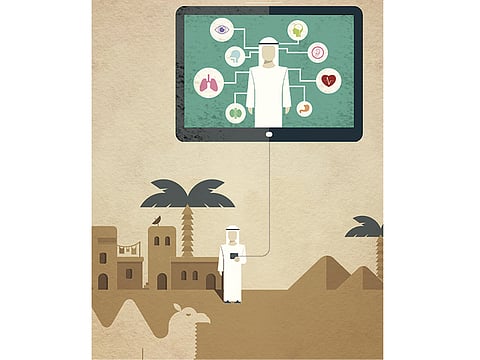Calling in real-time expert medical advice
While many challenges remain, the UAE needs to fast-track adoption of telemedicine

The UAE’s rapidly growing population, thriving tourism sector and growing prevalence of lifestyle diseases are placing an increasing strain on medical institutions to provide quality health care to a growing number of patients.
Over the past decade, the UAE has become a booming tourist destination. Dubai International Airport is now officially the world’s busiest airport, welcoming over 70 million passengers in 2014. Many of the passengers come for medical treatment, or require treatment while visiting.
This pressure on the industry will only increase over time as Dubai seeks to actively attract 500,000 medical tourists a year by 2020, according to the government’s medical tourism strategy announced last year. This would allow the emirate to equal medical tourism destinations such as the US and Singapore.
To help accommodate this influx, the Dubai Health Strategy 2013—25 aims to build three new major hospitals, add 40 new health care centres, and host 50 international medical conferences. But the strain on the sector will still be significant, especially in rural areas of the UAE.
Telemedicine — the use of digital technologies to provide health care services from a remote location — could be a solution to the increasing demand. By expanding the reach of UAE physicians, telemedicine would help relieve the shortage of quality health care practitioners, as well as reduce costs and give patients greater access to general and specialist care through a variety of digital mediums.
Imagine if an elderly woman in a remote part of the UAE could access her qualified specialist physician located in Dubai through video conferencing from her mobile phone, avoiding the excessive travel time and cost which might otherwise have been a deterrent to her seeking proper medical treatment prior to an emergency situation.
4G mobile networks
Or, consider a pregnant woman’s emergency delivery at a hospital not equipped to handle her birth complications, but which uses video conferencing and medical imaging sharing software to communicate with a specialist hospital to assist in the successful delivery.
Increasing advances in technology and the availability of 4G mobile networks has resulted in growing global channels for telemedicine to be utilised, therefore widening the patient groups that could benefit. Yet, in the UAE, telemedicine is still very much in its infancy.
The Abu Dhabi Health Authority currently has regulations setting minimum standards for telemedicine. However, the Dubai Health Authority only addresses teleradiology, not telemedicine, in their regulatory standards.
Across the entire UAE, information security and medical liability remain a real and perceived barrier to complete adoption and integration of telemedicine.
An entire generation of computer savvy criminals has turned hacking electronic data into a highly lucrative pursuit. As a result, information security of health care data has emerged as one of the biggest concerns in digital health.
Additionally, medical liability of doctors working across borders through digital health tools are concerns of both providers and patients. Yet, none of these legal issues are insurmountable.
Although the UAE has no consolidated information security law, there are elements of legislation at the federal level, and a few more specific laws in Dubai and Abu Dhabi, which generally govern data standards and information security in the UAE.
Last year, Abu Dhabi established a Data Standards Panel of governmental and industry representatives tasked with reviewing and recommending changes to electronic data exchange standards. This progression shows promise for the ongoing development of more robust standards and guidance on information security and data protection in the UAE.
Liability
Telemedicine medical liability issues can be complex, impacting both patient’s rights and protections, as well as the physician’s. For example, if a patient located in X country is misdiagnosed by a physician using telemedicine out of Y country, how does the patient file a medical liability claim against the foreign provider.
The courts in X jurisdiction would not have the authority to impose penalties against the foreign provider. In Abu Dhabi, for clinical and medical services provided through telemedicine, the regulations place liability on the originating locally licensed health care facility.
However, untested grey areas still exist across the country. Legal risk exposure can be reduced by proper development and implementation of facility telemedicine policies and guidelines, including continual training and licensing requirements, and proactive monitoring of staff performance.
Advances in telemedicine and digital health in the region will be determined by regulators developing efficient policies, enabling appropriate data protection and information security laws, and ensuring that the legal and regulatory constraints do not impede innovation.
Collaboration between regulators, the private sector, and health care professionals is key to the proper implementation of telemedicine, improving health care for citizens in the UAE, and reducing the increasing strain on the industry.
Particularly in this “Year of Innovation”, the UAE should champion innovative technology through enabling regulations and well targeted campaigns to raise awareness about digital health technologies, particularly telemedicine, and the ways this technology could increase and bridge the gap in access to health care services across the UAE.
Andrea Tithecott is Head of Regulatory Law at Al Tamimi & Co., while Christina Sochacki is Associate, Healthcare Practice Group, Al Tamimi & Co.
Sign up for the Daily Briefing
Get the latest news and updates straight to your inbox

